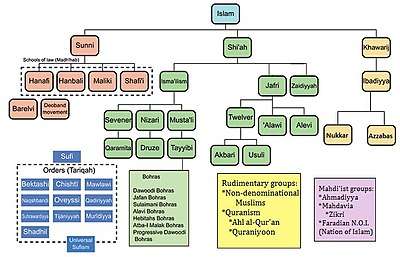Ja'fari jurisprudence
Jaʿfari jurisprudence (Arabic: الفقه الجعفري; also spelled Jafarite), Jaʿfari school or Jaʿfari fiqh[note A], is the school of jurisprudence (fiqh) in Twelver Shia Islam, named after the sixth Imam, Ja'far al-Sadiq.[1] In Iran, Ja'fari jurisprudence is enshrined in the constitution.[2]
| |||
|---|---|---|---|
| The Fourteen Infallibles | |||
|
|||
| Principles | |||
| Other beliefs | |||
| Practices | |||
| Holy cities | |||
| Groups | |||
|
|
|||
| Scholarship | |||
| Hadith collections | |||
|
|||
| Related topics | |||
| Related portals | |||
|
|||
| Part of a series on Islam Shia Islam |
|---|
 |
|
Beliefs and practices |
|
|
Holy women |
|
|
It differs from the predominant madhhabs of Sunni jurisprudence in its reliance on ijtihad, as well as on matters of inheritance, religious taxes, commerce, personal status, and the allowing of temporary marriage or mutʿa.[3] Since 1959, Jaʿfari jurisprudence has been afforded the status of “fifth school” along with the four Sunni schools by Azhar University.[4] In addition, it is one of the eight recognized madhhabs listed in the Amman Message of 2004 by the Jordanian monarch, and since endorsed by Sadiq al-Mahdi, former Prime Minister of Sudan.[5]
Branches

Usuli
This school of thought utilizes ijtihad by adopting reasoned argumentation in finding the laws of Islam. Usulis emphasize the role of Mujtahid who was capable of independently interpreting the sacred sources as an intermediary of the Hidden Imamas and thus serve as a guide to the community. This meant that legal interpretations were kept flexible to take account of changing conditions and the dynamics of the times.[6] This school of thought is predominant among most Shia.
Ayatollah Ruhollah Khomeini emphasized that Ja'fari jurisprudence is configured based on the recognition that epistemology is influenced by subjectivity. Accordingly, Ja'fari jurisprudence asserts Conventional Fiqh (objective) and Dynamic Fiqh (subjective). Through Dynamic Fiqh, discussed in the famous text by Javaher-al-Kalem (Arabic: جواهر الكلم), one must consider the concept of time, era, and age (Arabic: زمان) as well as the concept of place, location and venue (Arabic: مکان) since these dimensions of thought and reality affect the process of interpreting, understanding and extracting meaning from the commandments.[7]
See also
Bada
Twelvers, along with other Shia sects such as the Zaydis, reject predestination.[8][9][10][11] This belief is further emphasized by the Shia concept of Bada’, which states that God has not set a definite course for human history. Instead, God may alter the course of human history as is seen to be fit.
Nikah Mut'ah
Nikah mutʿah (Arabic: نكاح المتعة)," is a type of marriage used in Twelver Shia Islam, where the duration of the marriage and the dower must be specified and agreed upon in advance.[12][13](p242)[14](p47–53) It is a private contract made in a verbal or written format. A declaration of the intent to marry and an acceptance of the terms are required (as they are in nikah). Zaidi Shias, Ismaili Shias, and Sunni Muslims do not practice nikah mut'ah.
Taqiyah
In Shia Islam, taqiya (تقیة taqiyyah/taqīyah) is a form of religious veil,[15] or a legal dispensation whereby a believing individual can deny his faith or commit otherwise illegal or blasphemous acts, specially while they are in fear or at risk of significant persecution.[16] Once source for this understanding comes from al-Kafi.[17]
This practice was emphasized in Shi'a Islam whereby adherents may conceal their religion when they are under threat, persecution, or compulsion.[18] Taqiyya was developed to protect Shi'as who were usually in minority and under pressure, and Shia Muslims as the persecuted minority have taken recourse to dissimulation from the time of the mihna (persecution) under Al-Ma'mun in the 9th century, while the politically dominant Sunnites rarely found it necessary to resort to dissimulation.[19]
See also
- Outline of Islam
- The four schools of Sunni jurisprudence
Notes
- ^A In Arabic script: جعفري, strict transcriptions: Jaʻfarī or Ǧaʿfarī, /d͡ʒaʕfariː/; from the name: جعفر, Jaʻfar/Ǧaʿfar, /d͡ʒaʕfar/.
- John Corrigan, Frederick Denny, Martin S Jaffee, Carlos Eire (2011). Jews, Christians, Muslims: A Comparative Introduction to Monotheistic Religions. Cambridge University Press. 978-0205026340.CS1 maint: multiple names: authors list (link)
- http://ijtihadnet.com/book-islamic-law-according-jafari-school-jurisprudence-vol-2/
- Nasr, Vali (2006), The Shia Revival, Norton, p. 69
- Jafari: Shii Legal Thought and Jurisprudence
- Hassan Ahmed Ibrahim, "An Overview of al-Sadiq al-Madhi's Islamic Discourse." Taken from The Blackwell Companion to Contemporary Islamic Thought, pg. 172. Ed. Ibrahim Abu-Rabi'. Hoboken: Wiley-Blackwell, 2008. ISBN 9781405178488
- The Oxford Concise Dictionary of Politics, 2003:487.
- صحيفه نور
- Rizvi, Sayyid Sa'id AkhtarNeed of Religion p. 14.
- Florian Pohl, Florian. Islamic Beliefs, Practices, and Cultures, by Marshall Cavendish Corporation, p. 137.
- Greer, Charles Douglas. Religions of Man p. 239.
- , Rizvi, S. H. M.; Roy, Shibani; Dutta B. B. Muslims p. 20.
- Berg H. Method and theory in the study of Islamic origins, p 165 Brill 2003 ISBN 9004126023, 9789004126022. Accessed at Google Books 15 March 2014.
- Hughes T. A Dictionary of Islam p 424 Asian Educational Services 1 December 1995. Accessed 15 April 2014.
- Pohl, Florian. "Muslim world: modern muslim societies."p 50 Marshall Cavendish, 2010. ISBN 0761479279, 1780761479277 Accessed at Google Books 15 March 2014.
- Momen, Moojan (1985). An Introduction to Shi'i Islam. Yale University Press. pp. 39, 183. ISBN 978-0-300-03531-5.
- Stewart, Devin. "Islam in Spain after the Reconquista". Teaching Materials. The Hagop Kevorkian Center for Near Eastern Studies at New York University. Retrieved 6 August 2012.
- al-Kafi Volume 2. New York: The Islamic Seminary, Inc. January 2015. p. Chapter 93. ISBN 978-0-9914308-8-8.
- "Taqiyah". Oxford Dictionary of Islam. John L. Esposito, Ed. Oxford University Press. 2003. Retrieved 25 May 2011.
- Virani, Shafique N. (2009). The Ismailis in the Middle Ages: A History of Survival, a Search for Salvation. New York: Oxford University Press. p. 47f. ISBN 978-0-19-531173-0.
References
- McLean, Iain; McMillan, Alistair (eds.) (2003). The Oxford Concise Dictionary of Politics (2nd ed.). Oxford; New York: Oxford University Press. ISBN 0-19-280276-3. OCLC 464816415.CS1 maint: extra text: authors list (link)
External links
| Wikimedia Commons has media related to Ja'fari jurisprudence. |
- "Jafari: Shii Legal Thought and Jurisprudence" from Oxford Islamic Studies Online
- Some of Shi'a Islamic Laws books
- Islamic Laws of G.A. Sayyid Abulqasim al-Khoei
- Islamic Laws of G.A. Fazel Lankarani
- Islamic Laws of G.A. Syed Ali al-Husaini Seestani
- Towards an Understanding of the Shiite Authoritative Sources